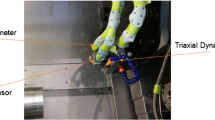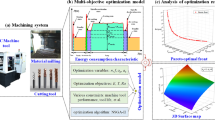Abstract
Machining stiffness, which serves the overall stability of a machine tool, plays a significant role in determining the resulting machining errors in a machine tool. Therefore, the machine tools can thus be improved to get high levels of precisions directly from what we behold as the most important determinant, the overall stiffness. In this paper, a novel approach modeling the static stiffness field of the machining space is being discussed. Within this method, a parametric model, considering six-directional static stiffness, is established to design and evaluate the static stiffness model of a high-performance computerized numerical control (CNC) machine tool. The result is then used for further discussions on the estimating and reducing of the machining errors. The machining errors are predicted by using the same CNC model under various load bearings considering the practical machining positions and stress conditions. Moreover, the effect of the six-directional static stiffness on the machining errors according to each position in the machining space is researched, where we investigate the possible solutions to reduce the machining errors with the processing technology put into consideration. In the end, by experimenting on boring-milling machining center, we verify the accuracy and efficiency of the proposed error prediction method by comparing the results from experimental data and those from finite element analysis. The proposed model is then proved to have great efficiency in optimizing the machine tool’s layout and structural design based. This improved modeling strongly suggests a favorable application for future manufacturing processes of machine tools.
Similar content being viewed by others
References
Rivin EI (1999) Stiffness and damping in mechanical design. Dekker, NY
Schellekens P, Rosielle N, Vermeulen H (1998) Design for precision: current status and trends. Ann Int Inst Prod Eng Res 47(2):557–586
Huang DT, Lee JJ (2001) On obtaining machine tool stiffness by CAE techniques. Int J Mach Tools Manuf 41(8):1149–1163
Olvera D, López LN, Compeán FI, Valdivielso AF, Lamikiz A, Campa FJ (2012) Analysis of the tool tip radial stiffness of turn-milling centers. Int J Adv Manuf Technol 60:883–891
Bustillo A, Plaza LM, Rodriguez M (2011) New strategy for the optimal design and manufacture of high performance milling heads. Rev Metal 6:462–476
Moez S, Zoubeir B, Ali Z, Gilles D, Maher B (2011) Simulation of the deflected cutting tool trajectory in complex surface milling. Int J Adv Manuf Technol 56:463–474
Li BT, Hong J, Liu ZF (2014) Stiffness design of machine tool structures by a biologically inspired topology optimization method. Int J Mach Tool Manuf 84:33–44
Xu JH, Zhang SY, Tan JR, Liu XJ (2012) Non-redundant tool trajectory generation for surface finish machining based on geodesic curvature matching. Int J Adv Manuf Technol 62(9):1169–1178
Cheng Q, Zhao HW, Zhang GJ, Gu PH, Cai LG (2014) An analytical approach for crucial geometric errors identification of multi-axis machine tool based on global sensitivity analysis. Int J Adv Manuf Technol 75:107–121
Yan SN, Li BT, Hong J (2015) Bionic design and verification of high-precision machine tool structures. Int J Adv Manuf Technol. doi:10.1007/s00170-015-7155-6
Lu YY, Wang LP, Guan LW (2008) Stiffness analysis and optimization of a hybrid machine tool based on the stiffness matrix. J Tsinghua Univ 48:180–183
Ertürka A, Özgüvena HN, Budakb E (2006) Analytical modeling of spindle-tool dynamics on machine tools using Timoshenko beam model and receptance coupling for the prediction of tool point FRF. Int J Mach Tool Manuf 46:1901–1912
Sanmiguel RE, Hidalgo MM, Jiménez-González JI, Martín-Alcántara A (2015) Analytical approaches to oscillators with nonlinear springs in parallel and series connections. Mech Mach Theory 93:39–52
Aydin G, Rajendra S (2013) Stiffness matrix formulation for double row angular contact ball bearings: analytical development and validation. J Sound Vib 332:5898–5916
Hong J, Talbot D, Kahraman A (2014) A semi-analytical load distribution model for side-fit involute splines. Mech Mach Theory 76:39–55
Olmedo A, Santiuste C, Barbero E (2014) An analytical model for the secondary bending prediction in single-lap composite bolted-joints. Compos Struct 111:354–361
Budak E (2006) Analytical models for high performance milling. Part I: cutting forces structural deflections and tolerance integrity. Int J Mach Tool Manuf 46:1478–1488
Wang YY, Huang T, Zhao XM, Mei JP, Chetwynd DG (2008) A semi-analytical approach for stiffness modeling of PKM by considering compliance of machine frame with complex geometry. Chin Sci Bull 53:2565–2574
Bonnemains T, Chanal H, Bouzgarrou BC, Pascal R (2009) Stiffness computation and identification of parallel kinematic machine tools. J Manuf Sci Eng Trans ASME 4131:289–305
Salgado MA, López LN, Lamikiz A, Muñoa J, Sánchez JA (2005) Evaluation of the stiffness chain on the deflection of end-mills under cutting forces. Int J Mach Tool Manuf 45:727–739
López LN, Lamikiz A (2009) Machine tools for high performance machining. Springer, London, pp 46–52
Vladimir TP (2011) Stiffness evaluation of machines and robots: minimum collinear stiffness value approach. J Mech Robot 3:1–9
Gosselin C (1990) Stiffness mapping for parallel manipulators. IEEE Trans Robot Autom 6:377–382
Chanal H, Duc E, Ray P (2006) A study of the impact of machine tool structure on machining processes. Int J Mach Tool Manu 46:98–106
Cardi AA, Firpi HA, Bement MT, Liang SY (2008) Workpiece dynamic analysis and prediction during chatter of turning process. Mech Syst Signal Process 22:1481–1494
Cheng Q, Zhao H, Zhao Y, Sun B, Gu P (2015) Machining accuracy reliability analysis of multi-axis machine tool based on Monte Carlo simulation. J Intell Manuf. doi:10.1007/s10845-015-1101-1
Uriarte L, Herrero A, Zatarain M, Santiso G, Lopéz LN, Lamikiz A, Albizuri J (2007) Error budget and stiffness chain assessment in a micromilling machine equipped with tools less than 0.3mm in diameter. Precis Eng 31:1–12
Agapiou JS (2008) Estimating the static stiffness for a spindle-toolholder-tooling system. Mach Sci Technol 12:77–99
Pashkevich A, Chabla D, Wenger P (2009) Stiffness analysis of over constrained parallel manipulators. Mech Mach Theory 44:966–982
Wu J, Wang JS, Wang LP, Li TM, You Z (2009) Study on the stiffness of a 5-DOF hybrid machine tool with actuation redundancy. Mech Mach Theory 44:289–305
Liu HT, Zhao WH (2010) Dynamic characteristic analysis for machine tools based on concept of generalized manufacturing space. Chin J Mech Eng 46:54–60
Rosen A, Gur O (2009) A transfer matrix model of large deformations of curved rods. Comput Struct 87:467–484
Rui XT, Zhang JS, Zhou QB (2014) Automatic deduction theorem of overall transfer equation of multibody system. Adv Mech Eng 42:4–16
Yan R, Peng FY, Li B (2008) A method of general stiffness modeling for multi-axis machine tool. Intell Robot Appl 53:1013–1021
Guyan RJ (1965) Reduction of stiffness and mass matrices. AIAA J 02:380
Yu J, Imbimbo M, Bettiet R (2010) Stiffness matrix properties for reduced order models of linear structural systems. J Appl Mech 77:1–8
Zhang XL (2002) Dynamic characteristics and application of mechanical surface. Chinese science and technology press, Beijing
Schneeberger (2011) Monorail and AMS Profiled linear guideways and integrated measuring systems. Schneeberger Co. Ltd, Shanghai, p 35–47
Grossi N, Sallese L, Scippa A, Campatelli G (2015) Speed-varying cutting force coefficient identification in milling. Precis Eng 42:321–334
Author information
Authors and Affiliations
Corresponding author
Rights and permissions
About this article
Cite this article
Gao, X., Li, B., Hong, J. et al. Stiffness modeling of machine tools based on machining space analysis. Int J Adv Manuf Technol 86, 2093–2106 (2016). https://doi.org/10.1007/s00170-015-8336-z
Received:
Accepted:
Published:
Issue Date:
DOI: https://doi.org/10.1007/s00170-015-8336-z




